Aspects of Contract and Negligence
VerifiedAdded on 2020/01/28
|14
|4125
|74
Report
AI Summary
This report comprehensively explores the aspects of contract and negligence law. It begins by defining a contract and its essential elements: offer, acceptance, and consideration. Different types of contracts (bilateral, unilateral, implied, expressed) are analyzed, along with the meaning and effect of contractual terms (conditions, intermediate terms, warranties). The report then delves into the nature of liability in contract versus tort, focusing on negligence and vicarious liability. Several case scenarios are presented and analyzed, applying the legal principles discussed to real-world situations. The report concludes by summarizing the key differences and interrelationships between contract and negligence law, emphasizing the importance of understanding both for legal professionals and individuals.
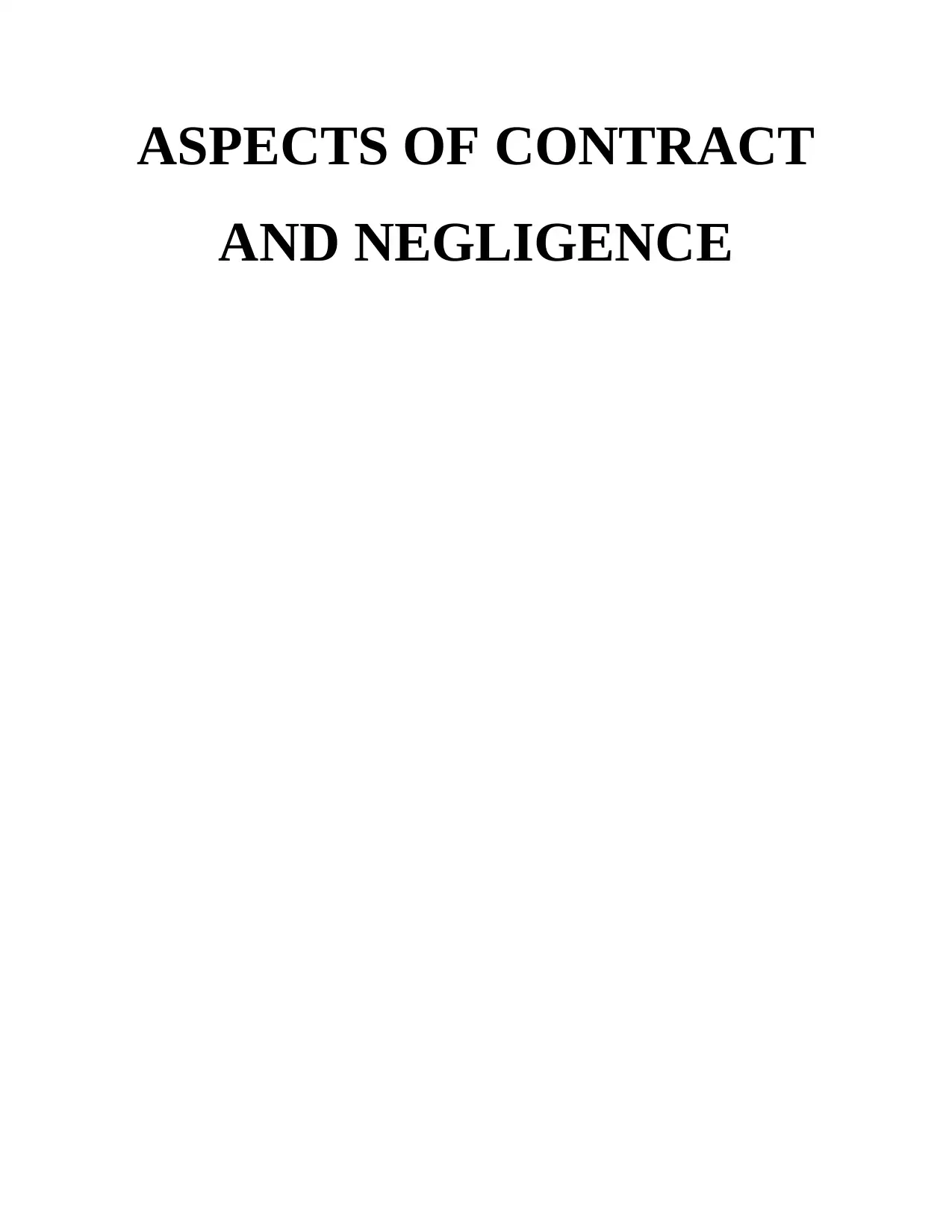
ASPECTS OF CONTRACT
AND NEGLIGENCE
AND NEGLIGENCE
Paraphrase This Document
Need a fresh take? Get an instant paraphrase of this document with our AI Paraphraser
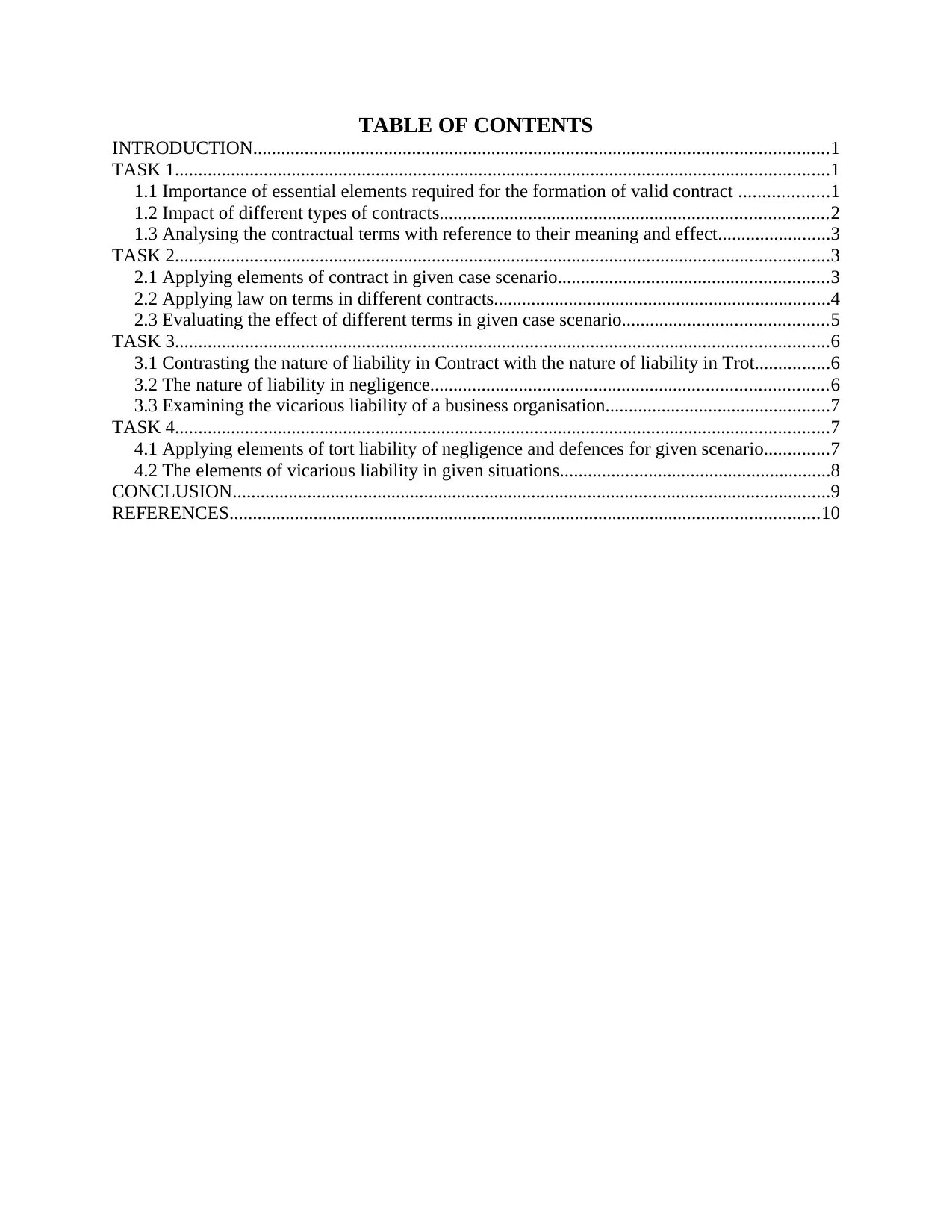
TABLE OF CONTENTS
INTRODUCTION...........................................................................................................................1
TASK 1............................................................................................................................................1
1.1 Importance of essential elements required for the formation of valid contract ...................1
1.2 Impact of different types of contracts...................................................................................2
1.3 Analysing the contractual terms with reference to their meaning and effect........................3
TASK 2............................................................................................................................................3
2.1 Applying elements of contract in given case scenario..........................................................3
2.2 Applying law on terms in different contracts........................................................................4
2.3 Evaluating the effect of different terms in given case scenario............................................5
TASK 3............................................................................................................................................6
3.1 Contrasting the nature of liability in Contract with the nature of liability in Trot................6
3.2 The nature of liability in negligence.....................................................................................6
3.3 Examining the vicarious liability of a business organisation................................................7
TASK 4............................................................................................................................................7
4.1 Applying elements of tort liability of negligence and defences for given scenario..............7
4.2 The elements of vicarious liability in given situations..........................................................8
CONCLUSION................................................................................................................................9
REFERENCES..............................................................................................................................10
INTRODUCTION...........................................................................................................................1
TASK 1............................................................................................................................................1
1.1 Importance of essential elements required for the formation of valid contract ...................1
1.2 Impact of different types of contracts...................................................................................2
1.3 Analysing the contractual terms with reference to their meaning and effect........................3
TASK 2............................................................................................................................................3
2.1 Applying elements of contract in given case scenario..........................................................3
2.2 Applying law on terms in different contracts........................................................................4
2.3 Evaluating the effect of different terms in given case scenario............................................5
TASK 3............................................................................................................................................6
3.1 Contrasting the nature of liability in Contract with the nature of liability in Trot................6
3.2 The nature of liability in negligence.....................................................................................6
3.3 Examining the vicarious liability of a business organisation................................................7
TASK 4............................................................................................................................................7
4.1 Applying elements of tort liability of negligence and defences for given scenario..............7
4.2 The elements of vicarious liability in given situations..........................................................8
CONCLUSION................................................................................................................................9
REFERENCES..............................................................................................................................10

⊘ This is a preview!⊘
Do you want full access?
Subscribe today to unlock all pages.

Trusted by 1+ million students worldwide
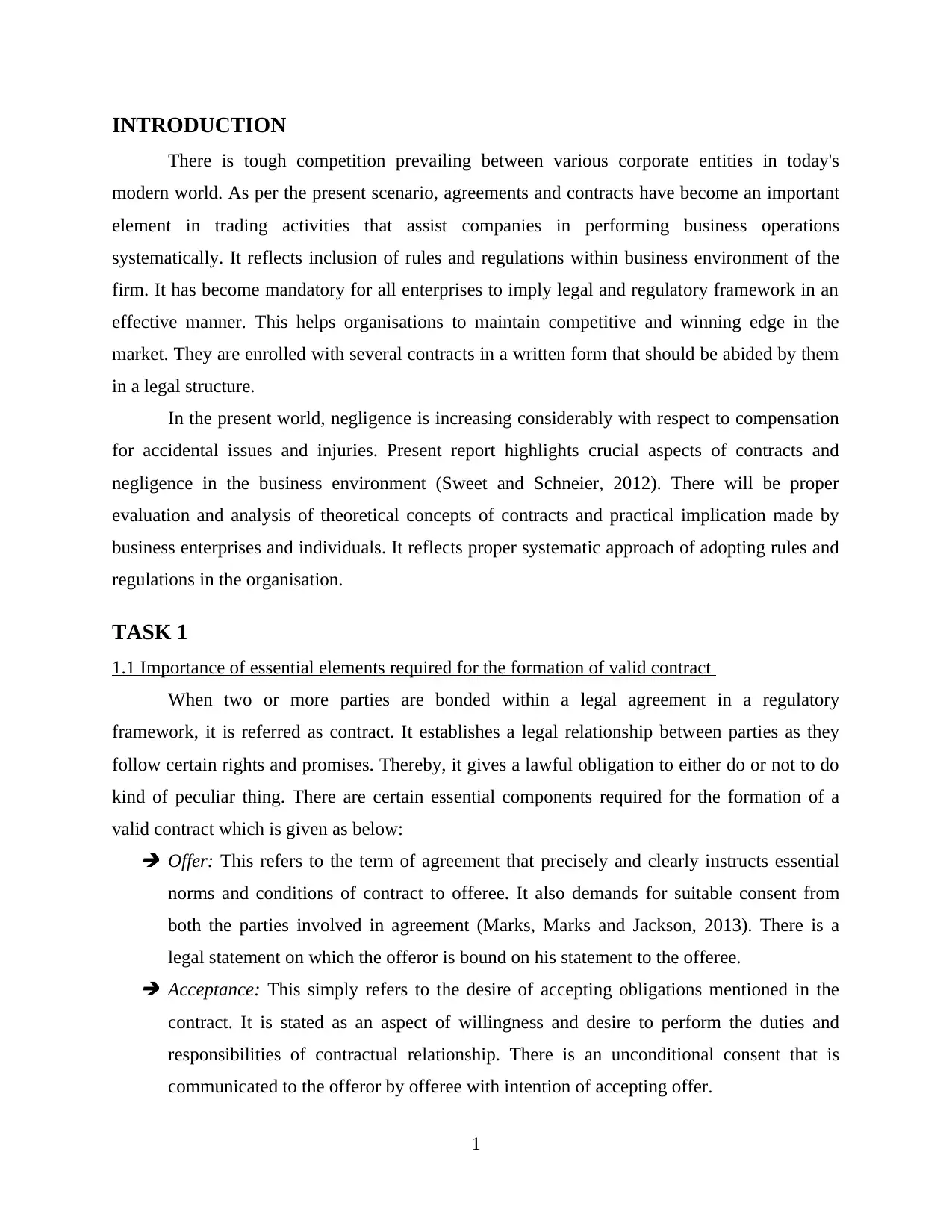
INTRODUCTION
There is tough competition prevailing between various corporate entities in today's
modern world. As per the present scenario, agreements and contracts have become an important
element in trading activities that assist companies in performing business operations
systematically. It reflects inclusion of rules and regulations within business environment of the
firm. It has become mandatory for all enterprises to imply legal and regulatory framework in an
effective manner. This helps organisations to maintain competitive and winning edge in the
market. They are enrolled with several contracts in a written form that should be abided by them
in a legal structure.
In the present world, negligence is increasing considerably with respect to compensation
for accidental issues and injuries. Present report highlights crucial aspects of contracts and
negligence in the business environment (Sweet and Schneier, 2012). There will be proper
evaluation and analysis of theoretical concepts of contracts and practical implication made by
business enterprises and individuals. It reflects proper systematic approach of adopting rules and
regulations in the organisation.
TASK 1
1.1 Importance of essential elements required for the formation of valid contract
When two or more parties are bonded within a legal agreement in a regulatory
framework, it is referred as contract. It establishes a legal relationship between parties as they
follow certain rights and promises. Thereby, it gives a lawful obligation to either do or not to do
kind of peculiar thing. There are certain essential components required for the formation of a
valid contract which is given as below: Offer: This refers to the term of agreement that precisely and clearly instructs essential
norms and conditions of contract to offeree. It also demands for suitable consent from
both the parties involved in agreement (Marks, Marks and Jackson, 2013). There is a
legal statement on which the offeror is bound on his statement to the offeree. Acceptance: This simply refers to the desire of accepting obligations mentioned in the
contract. It is stated as an aspect of willingness and desire to perform the duties and
responsibilities of contractual relationship. There is an unconditional consent that is
communicated to the offeror by offeree with intention of accepting offer.
1
There is tough competition prevailing between various corporate entities in today's
modern world. As per the present scenario, agreements and contracts have become an important
element in trading activities that assist companies in performing business operations
systematically. It reflects inclusion of rules and regulations within business environment of the
firm. It has become mandatory for all enterprises to imply legal and regulatory framework in an
effective manner. This helps organisations to maintain competitive and winning edge in the
market. They are enrolled with several contracts in a written form that should be abided by them
in a legal structure.
In the present world, negligence is increasing considerably with respect to compensation
for accidental issues and injuries. Present report highlights crucial aspects of contracts and
negligence in the business environment (Sweet and Schneier, 2012). There will be proper
evaluation and analysis of theoretical concepts of contracts and practical implication made by
business enterprises and individuals. It reflects proper systematic approach of adopting rules and
regulations in the organisation.
TASK 1
1.1 Importance of essential elements required for the formation of valid contract
When two or more parties are bonded within a legal agreement in a regulatory
framework, it is referred as contract. It establishes a legal relationship between parties as they
follow certain rights and promises. Thereby, it gives a lawful obligation to either do or not to do
kind of peculiar thing. There are certain essential components required for the formation of a
valid contract which is given as below: Offer: This refers to the term of agreement that precisely and clearly instructs essential
norms and conditions of contract to offeree. It also demands for suitable consent from
both the parties involved in agreement (Marks, Marks and Jackson, 2013). There is a
legal statement on which the offeror is bound on his statement to the offeree. Acceptance: This simply refers to the desire of accepting obligations mentioned in the
contract. It is stated as an aspect of willingness and desire to perform the duties and
responsibilities of contractual relationship. There is an unconditional consent that is
communicated to the offeror by offeree with intention of accepting offer.
1
Paraphrase This Document
Need a fresh take? Get an instant paraphrase of this document with our AI Paraphraser
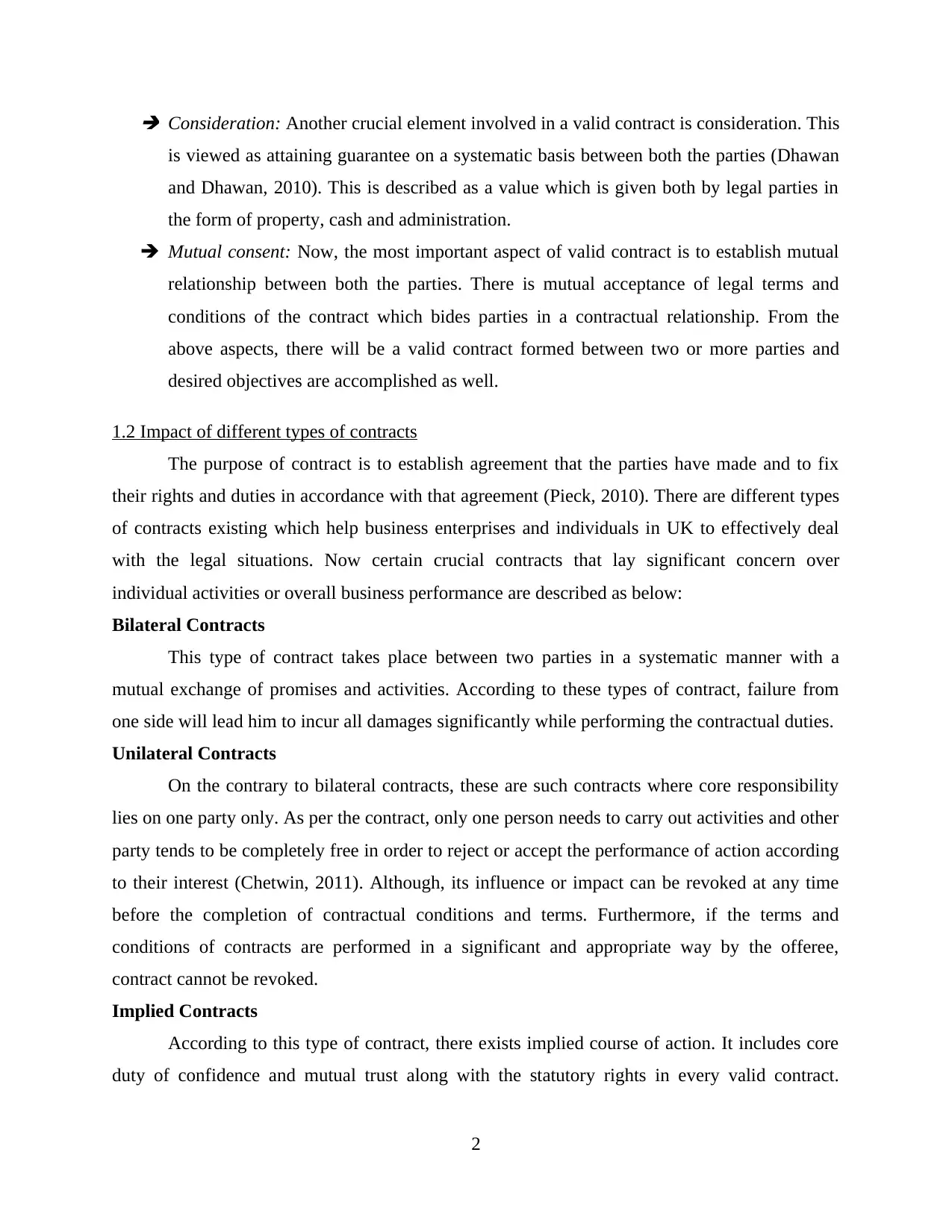
Consideration: Another crucial element involved in a valid contract is consideration. This
is viewed as attaining guarantee on a systematic basis between both the parties (Dhawan
and Dhawan, 2010). This is described as a value which is given both by legal parties in
the form of property, cash and administration.
Mutual consent: Now, the most important aspect of valid contract is to establish mutual
relationship between both the parties. There is mutual acceptance of legal terms and
conditions of the contract which bides parties in a contractual relationship. From the
above aspects, there will be a valid contract formed between two or more parties and
desired objectives are accomplished as well.
1.2 Impact of different types of contracts
The purpose of contract is to establish agreement that the parties have made and to fix
their rights and duties in accordance with that agreement (Pieck, 2010). There are different types
of contracts existing which help business enterprises and individuals in UK to effectively deal
with the legal situations. Now certain crucial contracts that lay significant concern over
individual activities or overall business performance are described as below:
Bilateral Contracts
This type of contract takes place between two parties in a systematic manner with a
mutual exchange of promises and activities. According to these types of contract, failure from
one side will lead him to incur all damages significantly while performing the contractual duties.
Unilateral Contracts
On the contrary to bilateral contracts, these are such contracts where core responsibility
lies on one party only. As per the contract, only one person needs to carry out activities and other
party tends to be completely free in order to reject or accept the performance of action according
to their interest (Chetwin, 2011). Although, its influence or impact can be revoked at any time
before the completion of contractual conditions and terms. Furthermore, if the terms and
conditions of contracts are performed in a significant and appropriate way by the offeree,
contract cannot be revoked.
Implied Contracts
According to this type of contract, there exists implied course of action. It includes core
duty of confidence and mutual trust along with the statutory rights in every valid contract.
2
is viewed as attaining guarantee on a systematic basis between both the parties (Dhawan
and Dhawan, 2010). This is described as a value which is given both by legal parties in
the form of property, cash and administration.
Mutual consent: Now, the most important aspect of valid contract is to establish mutual
relationship between both the parties. There is mutual acceptance of legal terms and
conditions of the contract which bides parties in a contractual relationship. From the
above aspects, there will be a valid contract formed between two or more parties and
desired objectives are accomplished as well.
1.2 Impact of different types of contracts
The purpose of contract is to establish agreement that the parties have made and to fix
their rights and duties in accordance with that agreement (Pieck, 2010). There are different types
of contracts existing which help business enterprises and individuals in UK to effectively deal
with the legal situations. Now certain crucial contracts that lay significant concern over
individual activities or overall business performance are described as below:
Bilateral Contracts
This type of contract takes place between two parties in a systematic manner with a
mutual exchange of promises and activities. According to these types of contract, failure from
one side will lead him to incur all damages significantly while performing the contractual duties.
Unilateral Contracts
On the contrary to bilateral contracts, these are such contracts where core responsibility
lies on one party only. As per the contract, only one person needs to carry out activities and other
party tends to be completely free in order to reject or accept the performance of action according
to their interest (Chetwin, 2011). Although, its influence or impact can be revoked at any time
before the completion of contractual conditions and terms. Furthermore, if the terms and
conditions of contracts are performed in a significant and appropriate way by the offeree,
contract cannot be revoked.
Implied Contracts
According to this type of contract, there exists implied course of action. It includes core
duty of confidence and mutual trust along with the statutory rights in every valid contract.
2
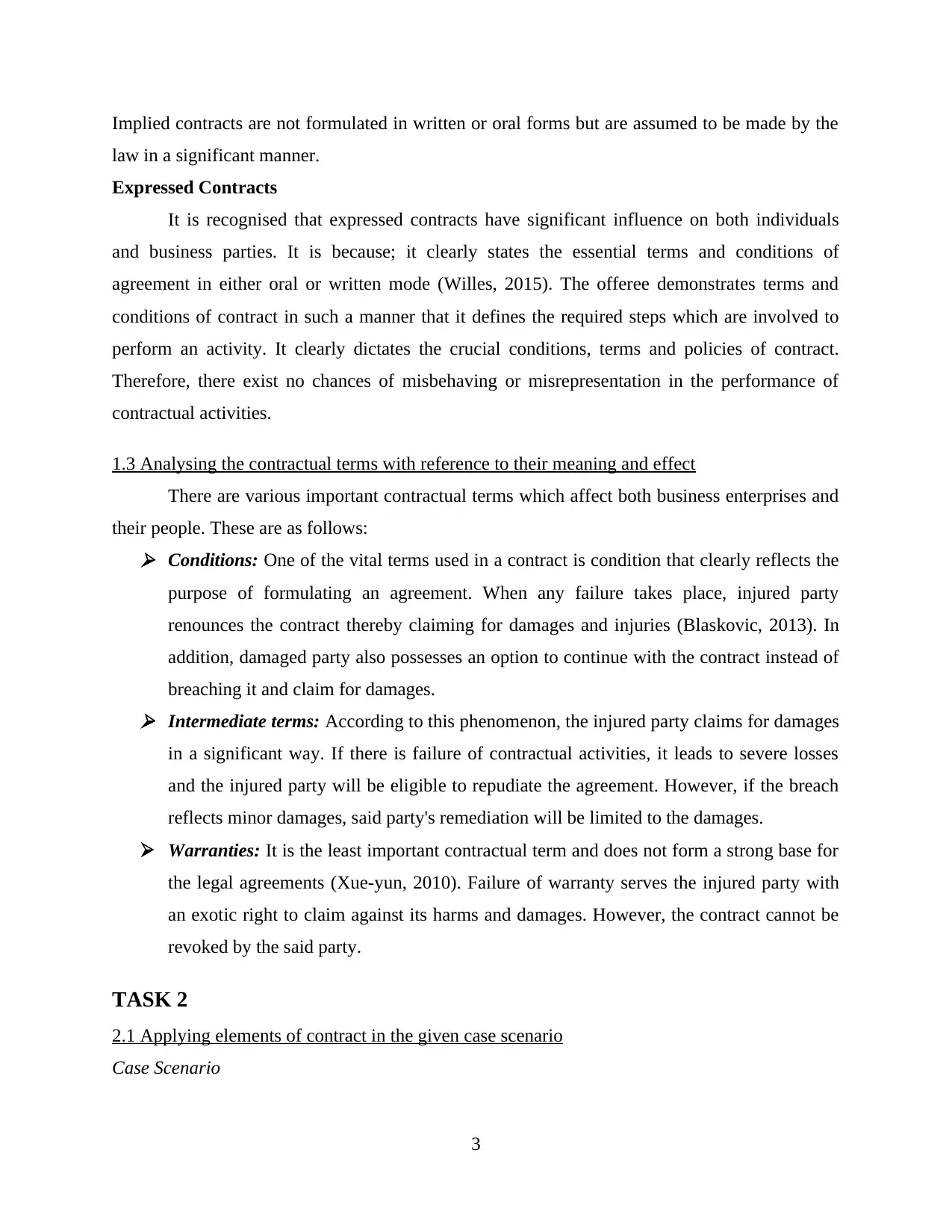
Implied contracts are not formulated in written or oral forms but are assumed to be made by the
law in a significant manner.
Expressed Contracts
It is recognised that expressed contracts have significant influence on both individuals
and business parties. It is because; it clearly states the essential terms and conditions of
agreement in either oral or written mode (Willes, 2015). The offeree demonstrates terms and
conditions of contract in such a manner that it defines the required steps which are involved to
perform an activity. It clearly dictates the crucial conditions, terms and policies of contract.
Therefore, there exist no chances of misbehaving or misrepresentation in the performance of
contractual activities.
1.3 Analysing the contractual terms with reference to their meaning and effect
There are various important contractual terms which affect both business enterprises and
their people. These are as follows: Conditions: One of the vital terms used in a contract is condition that clearly reflects the
purpose of formulating an agreement. When any failure takes place, injured party
renounces the contract thereby claiming for damages and injuries (Blaskovic, 2013). In
addition, damaged party also possesses an option to continue with the contract instead of
breaching it and claim for damages. Intermediate terms: According to this phenomenon, the injured party claims for damages
in a significant way. If there is failure of contractual activities, it leads to severe losses
and the injured party will be eligible to repudiate the agreement. However, if the breach
reflects minor damages, said party's remediation will be limited to the damages.
Warranties: It is the least important contractual term and does not form a strong base for
the legal agreements (Xue-yun, 2010). Failure of warranty serves the injured party with
an exotic right to claim against its harms and damages. However, the contract cannot be
revoked by the said party.
TASK 2
2.1 Applying elements of contract in the given case scenario
Case Scenario
3
law in a significant manner.
Expressed Contracts
It is recognised that expressed contracts have significant influence on both individuals
and business parties. It is because; it clearly states the essential terms and conditions of
agreement in either oral or written mode (Willes, 2015). The offeree demonstrates terms and
conditions of contract in such a manner that it defines the required steps which are involved to
perform an activity. It clearly dictates the crucial conditions, terms and policies of contract.
Therefore, there exist no chances of misbehaving or misrepresentation in the performance of
contractual activities.
1.3 Analysing the contractual terms with reference to their meaning and effect
There are various important contractual terms which affect both business enterprises and
their people. These are as follows: Conditions: One of the vital terms used in a contract is condition that clearly reflects the
purpose of formulating an agreement. When any failure takes place, injured party
renounces the contract thereby claiming for damages and injuries (Blaskovic, 2013). In
addition, damaged party also possesses an option to continue with the contract instead of
breaching it and claim for damages. Intermediate terms: According to this phenomenon, the injured party claims for damages
in a significant way. If there is failure of contractual activities, it leads to severe losses
and the injured party will be eligible to repudiate the agreement. However, if the breach
reflects minor damages, said party's remediation will be limited to the damages.
Warranties: It is the least important contractual term and does not form a strong base for
the legal agreements (Xue-yun, 2010). Failure of warranty serves the injured party with
an exotic right to claim against its harms and damages. However, the contract cannot be
revoked by the said party.
TASK 2
2.1 Applying elements of contract in the given case scenario
Case Scenario
3
⊘ This is a preview!⊘
Do you want full access?
Subscribe today to unlock all pages.

Trusted by 1+ million students worldwide
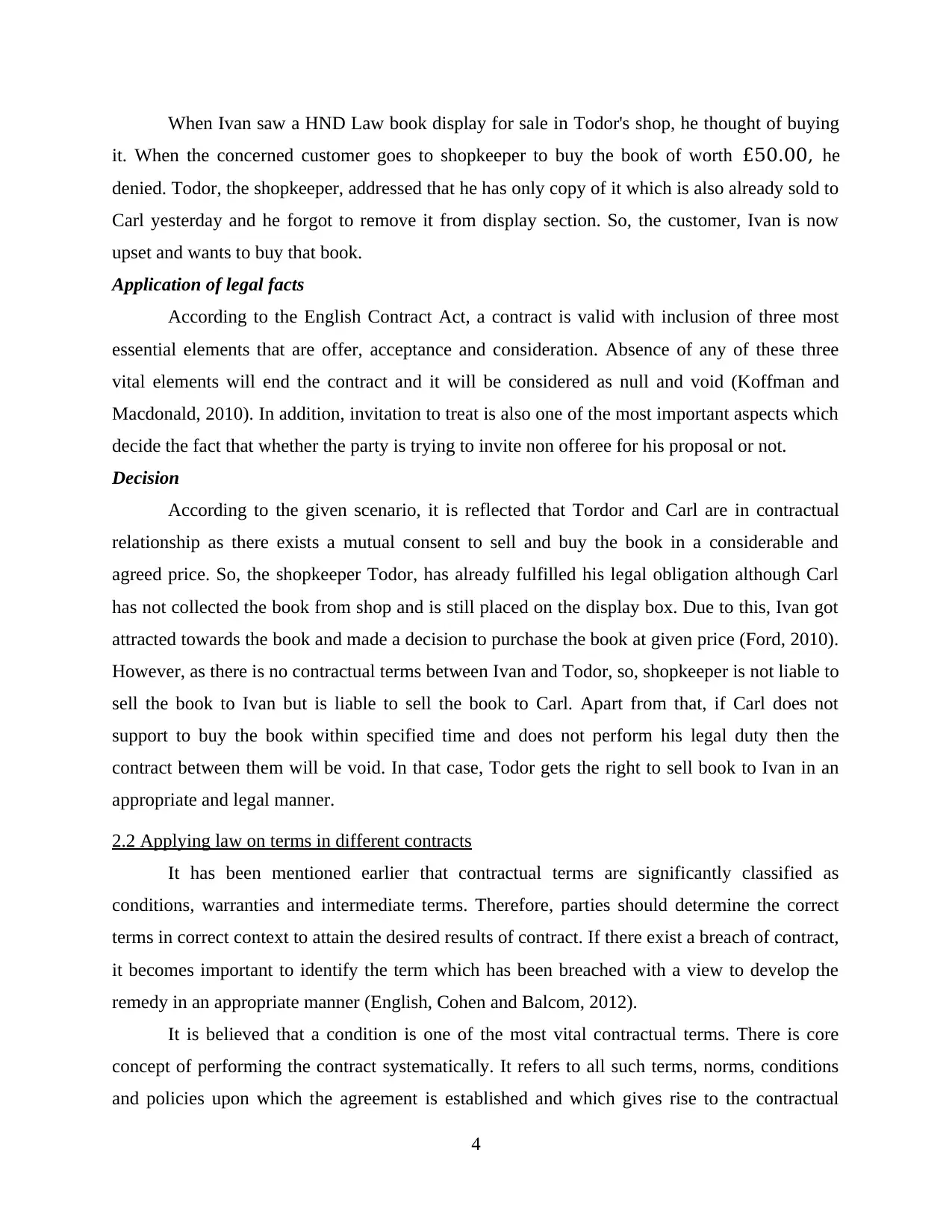
When Ivan saw a HND Law book display for sale in Todor's shop, he thought of buying
it. When the concerned customer goes to shopkeeper to buy the book of worth £50.00, he
denied. Todor, the shopkeeper, addressed that he has only copy of it which is also already sold to
Carl yesterday and he forgot to remove it from display section. So, the customer, Ivan is now
upset and wants to buy that book.
Application of legal facts
According to the English Contract Act, a contract is valid with inclusion of three most
essential elements that are offer, acceptance and consideration. Absence of any of these three
vital elements will end the contract and it will be considered as null and void (Koffman and
Macdonald, 2010). In addition, invitation to treat is also one of the most important aspects which
decide the fact that whether the party is trying to invite non offeree for his proposal or not.
Decision
According to the given scenario, it is reflected that Tordor and Carl are in contractual
relationship as there exists a mutual consent to sell and buy the book in a considerable and
agreed price. So, the shopkeeper Todor, has already fulfilled his legal obligation although Carl
has not collected the book from shop and is still placed on the display box. Due to this, Ivan got
attracted towards the book and made a decision to purchase the book at given price (Ford, 2010).
However, as there is no contractual terms between Ivan and Todor, so, shopkeeper is not liable to
sell the book to Ivan but is liable to sell the book to Carl. Apart from that, if Carl does not
support to buy the book within specified time and does not perform his legal duty then the
contract between them will be void. In that case, Todor gets the right to sell book to Ivan in an
appropriate and legal manner.
2.2 Applying law on terms in different contracts
It has been mentioned earlier that contractual terms are significantly classified as
conditions, warranties and intermediate terms. Therefore, parties should determine the correct
terms in correct context to attain the desired results of contract. If there exist a breach of contract,
it becomes important to identify the term which has been breached with a view to develop the
remedy in an appropriate manner (English, Cohen and Balcom, 2012).
It is believed that a condition is one of the most vital contractual terms. There is core
concept of performing the contract systematically. It refers to all such terms, norms, conditions
and policies upon which the agreement is established and which gives rise to the contractual
4
it. When the concerned customer goes to shopkeeper to buy the book of worth £50.00, he
denied. Todor, the shopkeeper, addressed that he has only copy of it which is also already sold to
Carl yesterday and he forgot to remove it from display section. So, the customer, Ivan is now
upset and wants to buy that book.
Application of legal facts
According to the English Contract Act, a contract is valid with inclusion of three most
essential elements that are offer, acceptance and consideration. Absence of any of these three
vital elements will end the contract and it will be considered as null and void (Koffman and
Macdonald, 2010). In addition, invitation to treat is also one of the most important aspects which
decide the fact that whether the party is trying to invite non offeree for his proposal or not.
Decision
According to the given scenario, it is reflected that Tordor and Carl are in contractual
relationship as there exists a mutual consent to sell and buy the book in a considerable and
agreed price. So, the shopkeeper Todor, has already fulfilled his legal obligation although Carl
has not collected the book from shop and is still placed on the display box. Due to this, Ivan got
attracted towards the book and made a decision to purchase the book at given price (Ford, 2010).
However, as there is no contractual terms between Ivan and Todor, so, shopkeeper is not liable to
sell the book to Ivan but is liable to sell the book to Carl. Apart from that, if Carl does not
support to buy the book within specified time and does not perform his legal duty then the
contract between them will be void. In that case, Todor gets the right to sell book to Ivan in an
appropriate and legal manner.
2.2 Applying law on terms in different contracts
It has been mentioned earlier that contractual terms are significantly classified as
conditions, warranties and intermediate terms. Therefore, parties should determine the correct
terms in correct context to attain the desired results of contract. If there exist a breach of contract,
it becomes important to identify the term which has been breached with a view to develop the
remedy in an appropriate manner (English, Cohen and Balcom, 2012).
It is believed that a condition is one of the most vital contractual terms. There is core
concept of performing the contract systematically. It refers to all such terms, norms, conditions
and policies upon which the agreement is established and which gives rise to the contractual
4
Paraphrase This Document
Need a fresh take? Get an instant paraphrase of this document with our AI Paraphraser
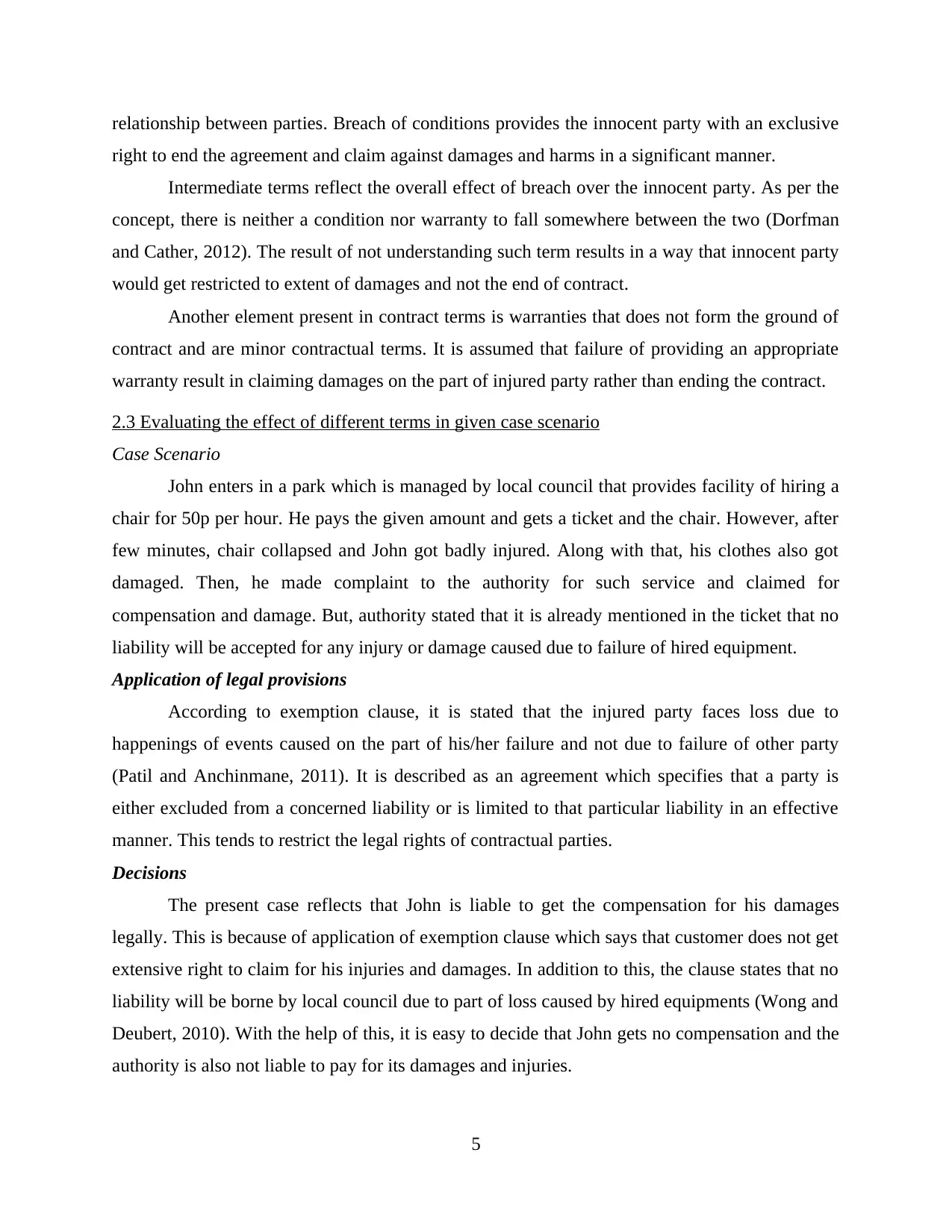
relationship between parties. Breach of conditions provides the innocent party with an exclusive
right to end the agreement and claim against damages and harms in a significant manner.
Intermediate terms reflect the overall effect of breach over the innocent party. As per the
concept, there is neither a condition nor warranty to fall somewhere between the two (Dorfman
and Cather, 2012). The result of not understanding such term results in a way that innocent party
would get restricted to extent of damages and not the end of contract.
Another element present in contract terms is warranties that does not form the ground of
contract and are minor contractual terms. It is assumed that failure of providing an appropriate
warranty result in claiming damages on the part of injured party rather than ending the contract.
2.3 Evaluating the effect of different terms in given case scenario
Case Scenario
John enters in a park which is managed by local council that provides facility of hiring a
chair for 50p per hour. He pays the given amount and gets a ticket and the chair. However, after
few minutes, chair collapsed and John got badly injured. Along with that, his clothes also got
damaged. Then, he made complaint to the authority for such service and claimed for
compensation and damage. But, authority stated that it is already mentioned in the ticket that no
liability will be accepted for any injury or damage caused due to failure of hired equipment.
Application of legal provisions
According to exemption clause, it is stated that the injured party faces loss due to
happenings of events caused on the part of his/her failure and not due to failure of other party
(Patil and Anchinmane, 2011). It is described as an agreement which specifies that a party is
either excluded from a concerned liability or is limited to that particular liability in an effective
manner. This tends to restrict the legal rights of contractual parties.
Decisions
The present case reflects that John is liable to get the compensation for his damages
legally. This is because of application of exemption clause which says that customer does not get
extensive right to claim for his injuries and damages. In addition to this, the clause states that no
liability will be borne by local council due to part of loss caused by hired equipments (Wong and
Deubert, 2010). With the help of this, it is easy to decide that John gets no compensation and the
authority is also not liable to pay for its damages and injuries.
5
right to end the agreement and claim against damages and harms in a significant manner.
Intermediate terms reflect the overall effect of breach over the innocent party. As per the
concept, there is neither a condition nor warranty to fall somewhere between the two (Dorfman
and Cather, 2012). The result of not understanding such term results in a way that innocent party
would get restricted to extent of damages and not the end of contract.
Another element present in contract terms is warranties that does not form the ground of
contract and are minor contractual terms. It is assumed that failure of providing an appropriate
warranty result in claiming damages on the part of injured party rather than ending the contract.
2.3 Evaluating the effect of different terms in given case scenario
Case Scenario
John enters in a park which is managed by local council that provides facility of hiring a
chair for 50p per hour. He pays the given amount and gets a ticket and the chair. However, after
few minutes, chair collapsed and John got badly injured. Along with that, his clothes also got
damaged. Then, he made complaint to the authority for such service and claimed for
compensation and damage. But, authority stated that it is already mentioned in the ticket that no
liability will be accepted for any injury or damage caused due to failure of hired equipment.
Application of legal provisions
According to exemption clause, it is stated that the injured party faces loss due to
happenings of events caused on the part of his/her failure and not due to failure of other party
(Patil and Anchinmane, 2011). It is described as an agreement which specifies that a party is
either excluded from a concerned liability or is limited to that particular liability in an effective
manner. This tends to restrict the legal rights of contractual parties.
Decisions
The present case reflects that John is liable to get the compensation for his damages
legally. This is because of application of exemption clause which says that customer does not get
extensive right to claim for his injuries and damages. In addition to this, the clause states that no
liability will be borne by local council due to part of loss caused by hired equipments (Wong and
Deubert, 2010). With the help of this, it is easy to decide that John gets no compensation and the
authority is also not liable to pay for its damages and injuries.
5
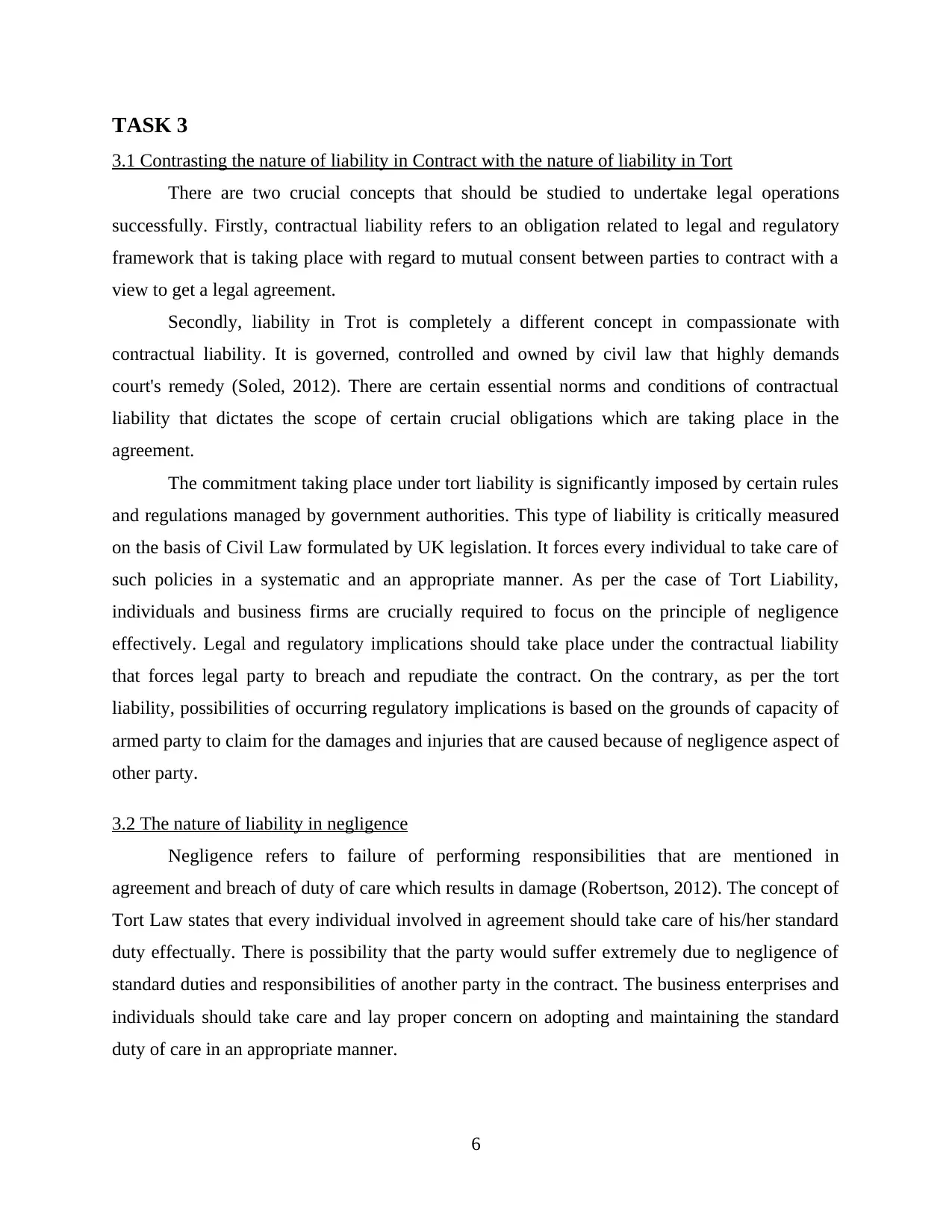
TASK 3
3.1 Contrasting the nature of liability in Contract with the nature of liability in Tort
There are two crucial concepts that should be studied to undertake legal operations
successfully. Firstly, contractual liability refers to an obligation related to legal and regulatory
framework that is taking place with regard to mutual consent between parties to contract with a
view to get a legal agreement.
Secondly, liability in Trot is completely a different concept in compassionate with
contractual liability. It is governed, controlled and owned by civil law that highly demands
court's remedy (Soled, 2012). There are certain essential norms and conditions of contractual
liability that dictates the scope of certain crucial obligations which are taking place in the
agreement.
The commitment taking place under tort liability is significantly imposed by certain rules
and regulations managed by government authorities. This type of liability is critically measured
on the basis of Civil Law formulated by UK legislation. It forces every individual to take care of
such policies in a systematic and an appropriate manner. As per the case of Tort Liability,
individuals and business firms are crucially required to focus on the principle of negligence
effectively. Legal and regulatory implications should take place under the contractual liability
that forces legal party to breach and repudiate the contract. On the contrary, as per the tort
liability, possibilities of occurring regulatory implications is based on the grounds of capacity of
armed party to claim for the damages and injuries that are caused because of negligence aspect of
other party.
3.2 The nature of liability in negligence
Negligence refers to failure of performing responsibilities that are mentioned in
agreement and breach of duty of care which results in damage (Robertson, 2012). The concept of
Tort Law states that every individual involved in agreement should take care of his/her standard
duty effectually. There is possibility that the party would suffer extremely due to negligence of
standard duties and responsibilities of another party in the contract. The business enterprises and
individuals should take care and lay proper concern on adopting and maintaining the standard
duty of care in an appropriate manner.
6
3.1 Contrasting the nature of liability in Contract with the nature of liability in Tort
There are two crucial concepts that should be studied to undertake legal operations
successfully. Firstly, contractual liability refers to an obligation related to legal and regulatory
framework that is taking place with regard to mutual consent between parties to contract with a
view to get a legal agreement.
Secondly, liability in Trot is completely a different concept in compassionate with
contractual liability. It is governed, controlled and owned by civil law that highly demands
court's remedy (Soled, 2012). There are certain essential norms and conditions of contractual
liability that dictates the scope of certain crucial obligations which are taking place in the
agreement.
The commitment taking place under tort liability is significantly imposed by certain rules
and regulations managed by government authorities. This type of liability is critically measured
on the basis of Civil Law formulated by UK legislation. It forces every individual to take care of
such policies in a systematic and an appropriate manner. As per the case of Tort Liability,
individuals and business firms are crucially required to focus on the principle of negligence
effectively. Legal and regulatory implications should take place under the contractual liability
that forces legal party to breach and repudiate the contract. On the contrary, as per the tort
liability, possibilities of occurring regulatory implications is based on the grounds of capacity of
armed party to claim for the damages and injuries that are caused because of negligence aspect of
other party.
3.2 The nature of liability in negligence
Negligence refers to failure of performing responsibilities that are mentioned in
agreement and breach of duty of care which results in damage (Robertson, 2012). The concept of
Tort Law states that every individual involved in agreement should take care of his/her standard
duty effectually. There is possibility that the party would suffer extremely due to negligence of
standard duties and responsibilities of another party in the contract. The business enterprises and
individuals should take care and lay proper concern on adopting and maintaining the standard
duty of care in an appropriate manner.
6
⊘ This is a preview!⊘
Do you want full access?
Subscribe today to unlock all pages.

Trusted by 1+ million students worldwide
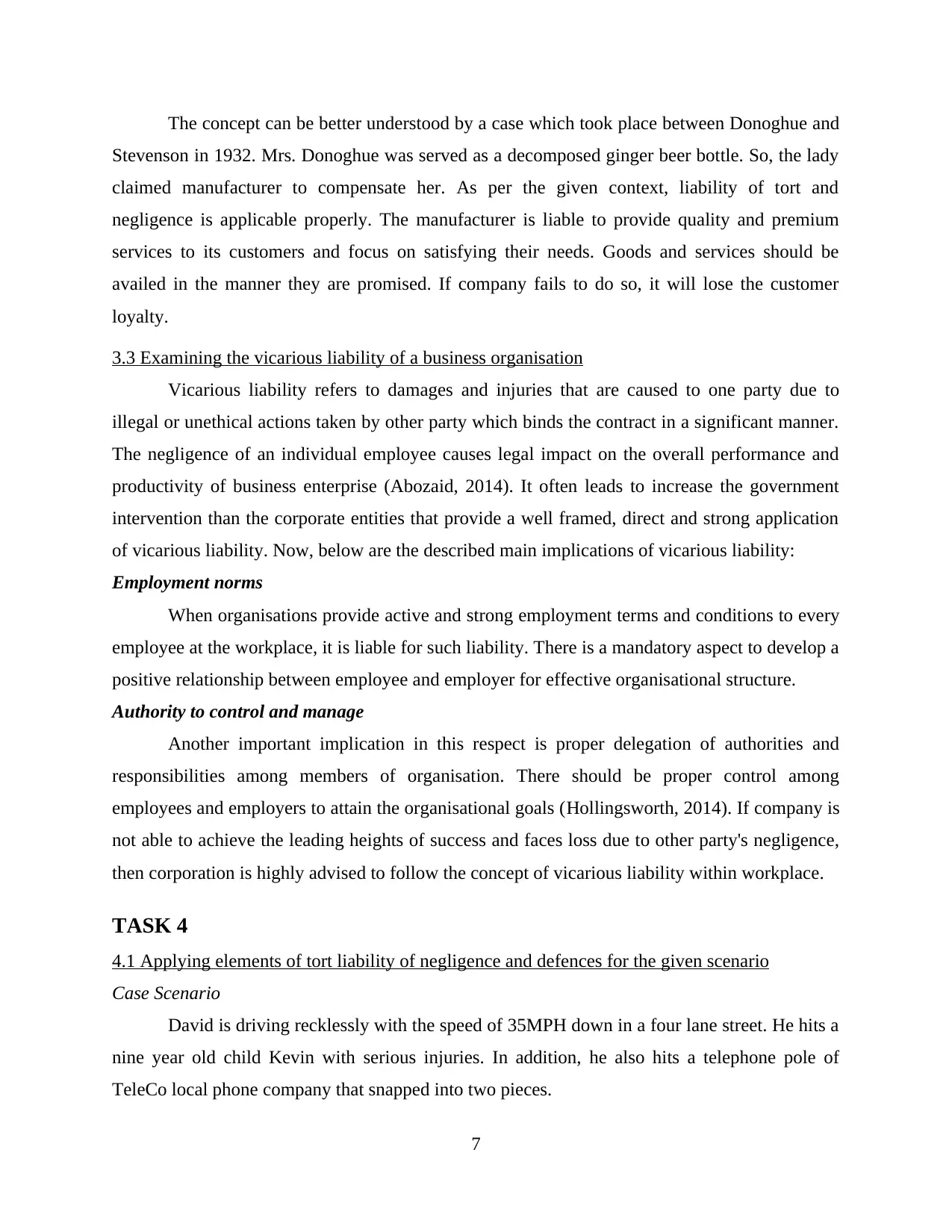
The concept can be better understood by a case which took place between Donoghue and
Stevenson in 1932. Mrs. Donoghue was served as a decomposed ginger beer bottle. So, the lady
claimed manufacturer to compensate her. As per the given context, liability of tort and
negligence is applicable properly. The manufacturer is liable to provide quality and premium
services to its customers and focus on satisfying their needs. Goods and services should be
availed in the manner they are promised. If company fails to do so, it will lose the customer
loyalty.
3.3 Examining the vicarious liability of a business organisation
Vicarious liability refers to damages and injuries that are caused to one party due to
illegal or unethical actions taken by other party which binds the contract in a significant manner.
The negligence of an individual employee causes legal impact on the overall performance and
productivity of business enterprise (Abozaid, 2014). It often leads to increase the government
intervention than the corporate entities that provide a well framed, direct and strong application
of vicarious liability. Now, below are the described main implications of vicarious liability:
Employment norms
When organisations provide active and strong employment terms and conditions to every
employee at the workplace, it is liable for such liability. There is a mandatory aspect to develop a
positive relationship between employee and employer for effective organisational structure.
Authority to control and manage
Another important implication in this respect is proper delegation of authorities and
responsibilities among members of organisation. There should be proper control among
employees and employers to attain the organisational goals (Hollingsworth, 2014). If company is
not able to achieve the leading heights of success and faces loss due to other party's negligence,
then corporation is highly advised to follow the concept of vicarious liability within workplace.
TASK 4
4.1 Applying elements of tort liability of negligence and defences for the given scenario
Case Scenario
David is driving recklessly with the speed of 35MPH down in a four lane street. He hits a
nine year old child Kevin with serious injuries. In addition, he also hits a telephone pole of
TeleCo local phone company that snapped into two pieces.
7
Stevenson in 1932. Mrs. Donoghue was served as a decomposed ginger beer bottle. So, the lady
claimed manufacturer to compensate her. As per the given context, liability of tort and
negligence is applicable properly. The manufacturer is liable to provide quality and premium
services to its customers and focus on satisfying their needs. Goods and services should be
availed in the manner they are promised. If company fails to do so, it will lose the customer
loyalty.
3.3 Examining the vicarious liability of a business organisation
Vicarious liability refers to damages and injuries that are caused to one party due to
illegal or unethical actions taken by other party which binds the contract in a significant manner.
The negligence of an individual employee causes legal impact on the overall performance and
productivity of business enterprise (Abozaid, 2014). It often leads to increase the government
intervention than the corporate entities that provide a well framed, direct and strong application
of vicarious liability. Now, below are the described main implications of vicarious liability:
Employment norms
When organisations provide active and strong employment terms and conditions to every
employee at the workplace, it is liable for such liability. There is a mandatory aspect to develop a
positive relationship between employee and employer for effective organisational structure.
Authority to control and manage
Another important implication in this respect is proper delegation of authorities and
responsibilities among members of organisation. There should be proper control among
employees and employers to attain the organisational goals (Hollingsworth, 2014). If company is
not able to achieve the leading heights of success and faces loss due to other party's negligence,
then corporation is highly advised to follow the concept of vicarious liability within workplace.
TASK 4
4.1 Applying elements of tort liability of negligence and defences for the given scenario
Case Scenario
David is driving recklessly with the speed of 35MPH down in a four lane street. He hits a
nine year old child Kevin with serious injuries. In addition, he also hits a telephone pole of
TeleCo local phone company that snapped into two pieces.
7
Paraphrase This Document
Need a fresh take? Get an instant paraphrase of this document with our AI Paraphraser
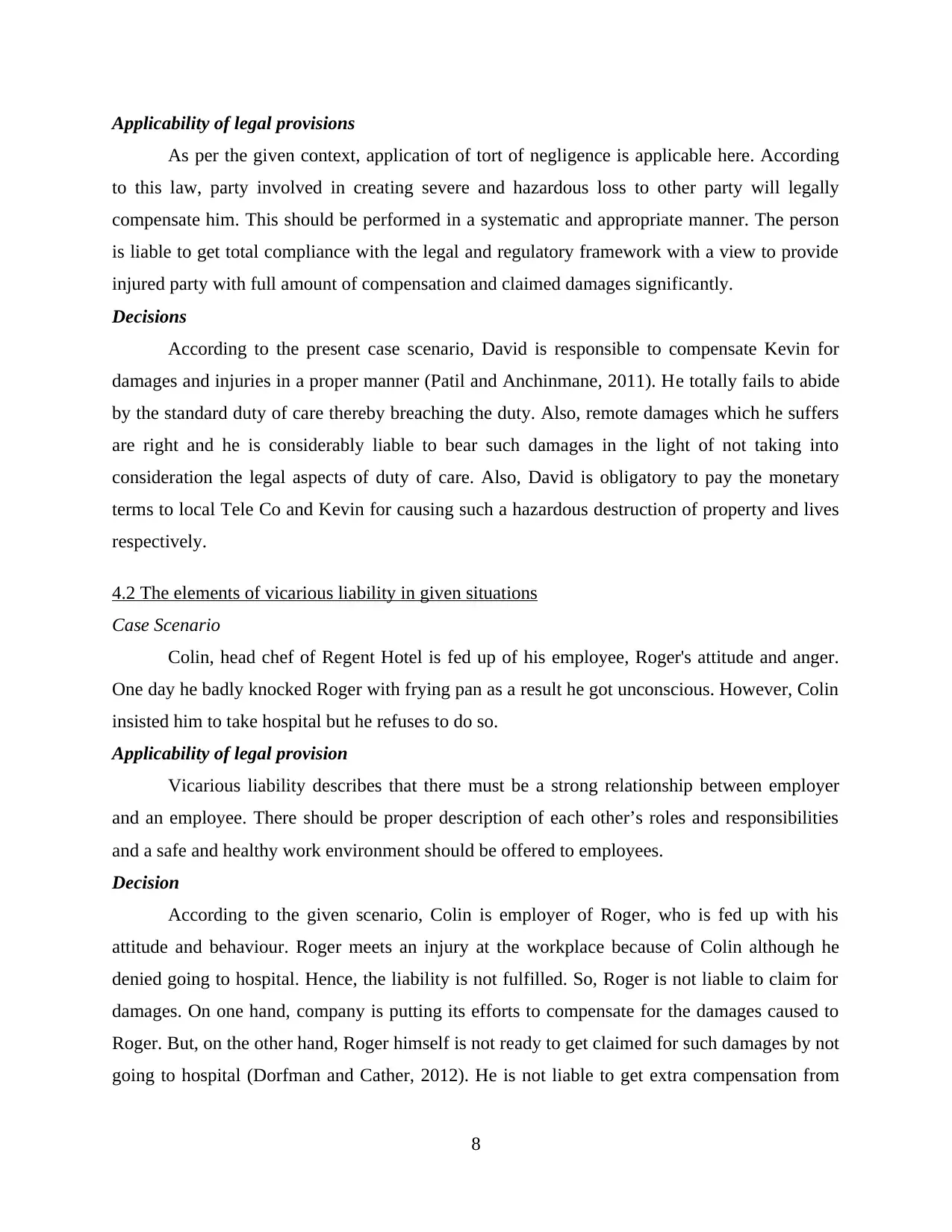
Applicability of legal provisions
As per the given context, application of tort of negligence is applicable here. According
to this law, party involved in creating severe and hazardous loss to other party will legally
compensate him. This should be performed in a systematic and appropriate manner. The person
is liable to get total compliance with the legal and regulatory framework with a view to provide
injured party with full amount of compensation and claimed damages significantly.
Decisions
According to the present case scenario, David is responsible to compensate Kevin for
damages and injuries in a proper manner (Patil and Anchinmane, 2011). He totally fails to abide
by the standard duty of care thereby breaching the duty. Also, remote damages which he suffers
are right and he is considerably liable to bear such damages in the light of not taking into
consideration the legal aspects of duty of care. Also, David is obligatory to pay the monetary
terms to local Tele Co and Kevin for causing such a hazardous destruction of property and lives
respectively.
4.2 The elements of vicarious liability in given situations
Case Scenario
Colin, head chef of Regent Hotel is fed up of his employee, Roger's attitude and anger.
One day he badly knocked Roger with frying pan as a result he got unconscious. However, Colin
insisted him to take hospital but he refuses to do so.
Applicability of legal provision
Vicarious liability describes that there must be a strong relationship between employer
and an employee. There should be proper description of each other’s roles and responsibilities
and a safe and healthy work environment should be offered to employees.
Decision
According to the given scenario, Colin is employer of Roger, who is fed up with his
attitude and behaviour. Roger meets an injury at the workplace because of Colin although he
denied going to hospital. Hence, the liability is not fulfilled. So, Roger is not liable to claim for
damages. On one hand, company is putting its efforts to compensate for the damages caused to
Roger. But, on the other hand, Roger himself is not ready to get claimed for such damages by not
going to hospital (Dorfman and Cather, 2012). He is not liable to get extra compensation from
8
As per the given context, application of tort of negligence is applicable here. According
to this law, party involved in creating severe and hazardous loss to other party will legally
compensate him. This should be performed in a systematic and appropriate manner. The person
is liable to get total compliance with the legal and regulatory framework with a view to provide
injured party with full amount of compensation and claimed damages significantly.
Decisions
According to the present case scenario, David is responsible to compensate Kevin for
damages and injuries in a proper manner (Patil and Anchinmane, 2011). He totally fails to abide
by the standard duty of care thereby breaching the duty. Also, remote damages which he suffers
are right and he is considerably liable to bear such damages in the light of not taking into
consideration the legal aspects of duty of care. Also, David is obligatory to pay the monetary
terms to local Tele Co and Kevin for causing such a hazardous destruction of property and lives
respectively.
4.2 The elements of vicarious liability in given situations
Case Scenario
Colin, head chef of Regent Hotel is fed up of his employee, Roger's attitude and anger.
One day he badly knocked Roger with frying pan as a result he got unconscious. However, Colin
insisted him to take hospital but he refuses to do so.
Applicability of legal provision
Vicarious liability describes that there must be a strong relationship between employer
and an employee. There should be proper description of each other’s roles and responsibilities
and a safe and healthy work environment should be offered to employees.
Decision
According to the given scenario, Colin is employer of Roger, who is fed up with his
attitude and behaviour. Roger meets an injury at the workplace because of Colin although he
denied going to hospital. Hence, the liability is not fulfilled. So, Roger is not liable to claim for
damages. On one hand, company is putting its efforts to compensate for the damages caused to
Roger. But, on the other hand, Roger himself is not ready to get claimed for such damages by not
going to hospital (Dorfman and Cather, 2012). He is not liable to get extra compensation from
8
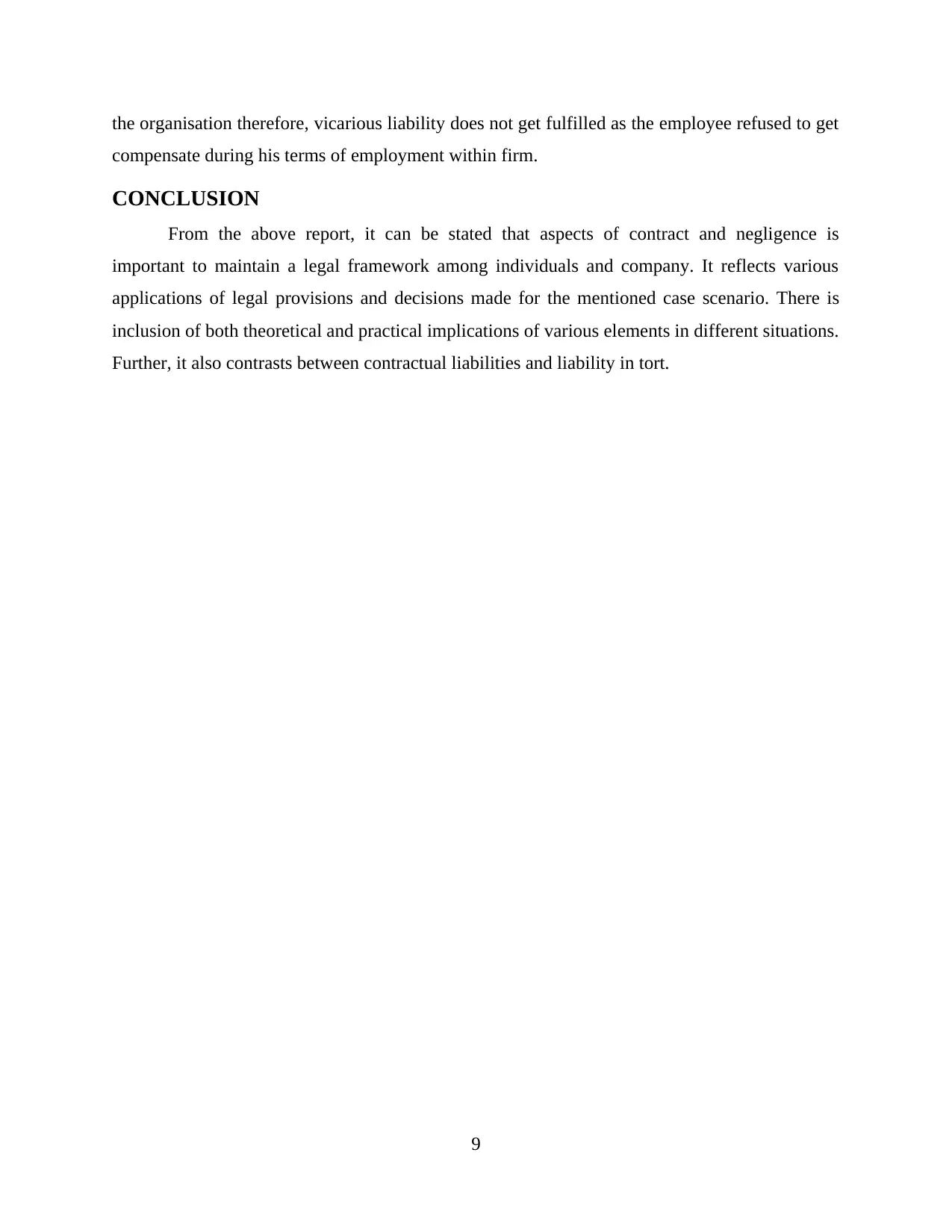
the organisation therefore, vicarious liability does not get fulfilled as the employee refused to get
compensate during his terms of employment within firm.
CONCLUSION
From the above report, it can be stated that aspects of contract and negligence is
important to maintain a legal framework among individuals and company. It reflects various
applications of legal provisions and decisions made for the mentioned case scenario. There is
inclusion of both theoretical and practical implications of various elements in different situations.
Further, it also contrasts between contractual liabilities and liability in tort.
9
compensate during his terms of employment within firm.
CONCLUSION
From the above report, it can be stated that aspects of contract and negligence is
important to maintain a legal framework among individuals and company. It reflects various
applications of legal provisions and decisions made for the mentioned case scenario. There is
inclusion of both theoretical and practical implications of various elements in different situations.
Further, it also contrasts between contractual liabilities and liability in tort.
9
⊘ This is a preview!⊘
Do you want full access?
Subscribe today to unlock all pages.

Trusted by 1+ million students worldwide
1 out of 14
Related Documents
Your All-in-One AI-Powered Toolkit for Academic Success.
+13062052269
info@desklib.com
Available 24*7 on WhatsApp / Email
![[object Object]](/_next/static/media/star-bottom.7253800d.svg)
Unlock your academic potential
Copyright © 2020–2025 A2Z Services. All Rights Reserved. Developed and managed by ZUCOL.





